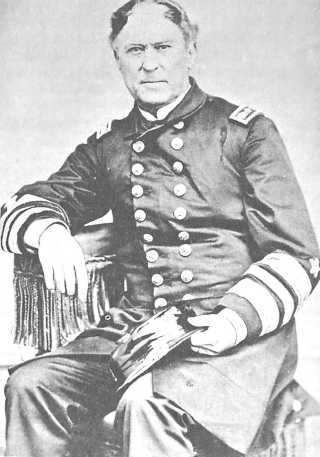| |
The nation’s scientists and inventors contributed
many innovations and, by war’s end, the Navy was
technically the equal of any on the sea.
The most famous naval battle of the war served as
a preview of things to come. This was the battle
between the USS Monitor and CSS Virginia (ex-USS
Merrimac). That naval conflict probably attracted
more attention than any in our history. Fighting the
first action of its kind in history, the ironclads
conclusively demonstrated the superiority of metal
over wood. The battle of the ironclads contrasted with
the easy victories of the Virginia over the unarmored
ships Cumberland and Congress on the previous day.
Leaders in both the Union navy and the
Confederate navy contributed to our naval traditions.
From these valiant leaders we learned the
importance of attention to detail, a progressive
outlook, a sense of humor, and persistence in the face
of adversity.
DAVID G. FARRAGUT
Among the outstanding naval leaders of the Civil
War was David G. Farragut (1801-1870). Like many
others in the early days of the Navy, Farragut (fig. 2-
9) entered the service as a youngster. He was a
midshipman before he was 10 years old. By the time
he was 21, he was experienced at shiphandling and
leadership.
When the Civil War broke out in 1861, Farragut,
then aged 60, had already served 49 years in the
Navy. At this time he was awaiting orders in Norfolk,
where he and his wife had made their home for
almost 17 years. Southern friends, urging him to
espouse the Confederate cause, were left in no doubt
as to his sympathies and convictions. “I would see
every man of you damned before I would raise my
hand against the flag.” With that declaration of
allegiance, he hurried north to serve with the United
States Navy. Farragut’s New Orleans campaign
was one of the most brilliant of the war. Where
logistics was concerned, Farragut displayed an
impressive knowledge of the art of moving men and
supplies. He is credited with being the first American
officer who fully understood the strategic deploy-
ment of a fleet and coordinated the operations of his
vessels accordingly.
Farragut is best remembered for the incident that
occurred at Mobile Bay while he was stationed on the
Hartford. During the critical phase of battle, mines
(then called torpedoes) were reported ahead.
Farragut knew that the monitor Tecumseh, with
134.12
Figure 2-9.-The statement of David G. Farragut,
tactician and strategist, that “the best
defense is a well-directed fire from your own
guns” became a Navy axiom.
almost all hands, had just gone down in that area.
His response, would echo throughout history as a
slogan for driving leadership—“Damn the torpedoes!
Full speed ahead!” As Farragut suspected, most of the
enemy’s underwater weapons had deteriorated from
long submersion, so the fleet got through. This
engagement shows another example of Farragut’s
genius for planning. He had spent 2 days making
sure his ships were prepared for the run. Heavy
anchor cables were fastened alongside the wooden
sides to serve as “chain armor” for the engines and
boilers. The ships were daubed with mud (primitive
camouflage), and water buckets were readied for fire
fighting. As a tactician and strategist, Farragut was
unexcelled by any of his peers. His statement, “the
best protection against the enemy’s fire is a well-
directed fire from your own guns,” became a principle
of naval warfare. However, Farragut gave the Navy
much more than valiant slogans;
2-12
|

